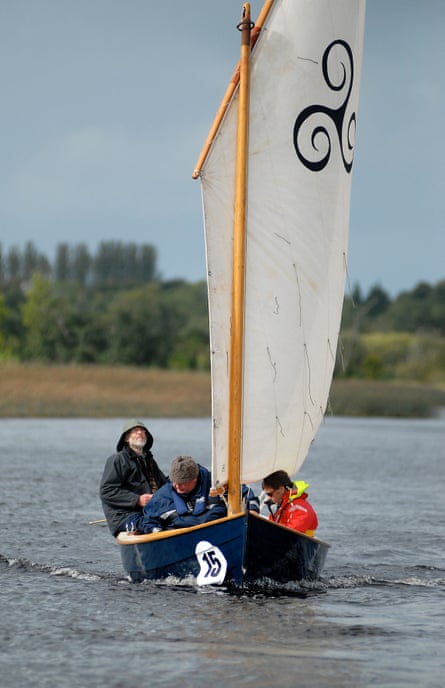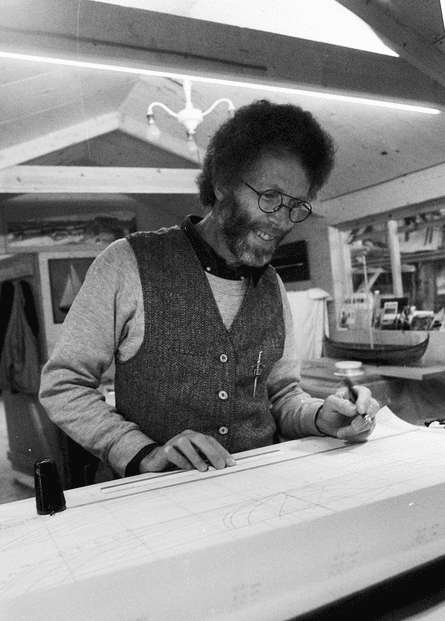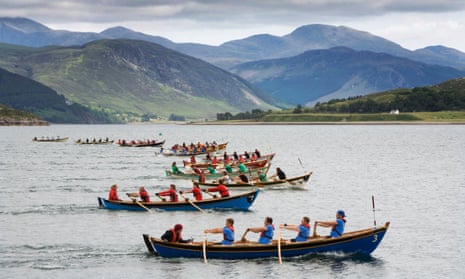During the winter of 1981-82, in a cold draughty shed in Cookham Dean on the River Thames in Berkshire, Iain Oughtred, who has died aged 84, built a boat that would change the world of small boat building. The craft was just 12ft long and based on a traditional Whitehall design built in the thousands in the US. But, whereas the American boats were made in solid timber held together with screws and rivets, Iain chose to build his in plywood and epoxy – the materials of the future, as he saw it. Up until then, boat designs for amateur construction, such as the popular Mirror dinghy, tended to be intrinsically functional (read ugly); Iain proved they could be beautiful too.
His Acorn skiff was picked up by the US magazine WoodenBoat, which described it as “a sweet-lined, slippery little jewel”, and added the drawings to its list of stock plans available to buy. It was the income from this design, as well as dozens more added to his list over the years, that allowed Iain to pursue his chosen career as a boat designer. Over the next 40 years, he would draw more than 100 designs – for boats ranging from 6ft to 30ft long – which would be built around the world by amateurs and professionals alike. Although not always the easiest to build, his designs were considered the pinnacle of the type and endowed him with almost cult status in the wooden boat community.

At the start of his career, Iain was in awe of the traditional boats of the US, which had been thoroughly documented by maritime historians such as Howard Chapelle and John Gardner. Not surprisingly, his early designs for dories and skiffs were inspired by this dominant American heritage, and even his canoe designs were variations on a popular American type. That all changed in the mid-1980s, when British wooden boat enthusiasts woke up to the fact that the UK had its own rich tradition of indigenous boat types to draw upon. The publication of Eric McKee’s seminal book Working Boats of Britain in 1983, with its free-flowing contemporary illustrations, was a turning point in that movement.
Iain responded by producing another landmark design. The Caledonia Yawl was loosely based on the working boats of Shetland, the sixareens: those hardy beasts of burden that were themselves inspired by Norwegian workboats. But Iain did not simply copy the design. He stripped it back to its essence, took out what was unnecessary (mainly a lot of weight), and reimagined it for the late 20th century. What emerged was a perfectly formed little sea boat, built out of modern materials and therefore more suited to modern living, which was at once thoroughly traditional and yet recognisably his own design.
Iain explained his approach to me when I visited him on the Isle of Skye while researching my biography Iain Oughtred: A Life in Wooden Boats (2009): “I had no intention of trying to design an actual Shetland sixareen,” he said. “The commission was for a glued plywood boat, with a completely different purpose to the original. It had to be lighter, more versatile and with better all-round sailing performance – and simple to build. At the same time, I wanted to retain the graceful character and extraordinary seagoing ability of the traditional boats. The challenge was how to evolve tradition, and how far you should go. It’s easy to start with a Shetland boat, see ways to make it go faster and then lose the whole point. But at the same time, if you’re designing a different boat for a different purpose, then it should look different too.”
Born in Melbourne, Australia, Iain was one of the seven children of Douglas, the manager of a scientific instruments company, and his wife, Jean (after whom Iain would later name two boats). The family moved to Sydney when Iain was nine, and he learned to sail at the Mosman Amateur Sailing Club on Sydney Harbour. As a young man, he designed and built several race-winning dinghies and eventually got a job as a draughtsman at a naval architect’s office in Sydney.

Feeling a misfit in Australia, he first visited Europe in 1964 and spent the next 17 years moving peripatetically between his homeland, Britain and the US, and working at temporary jobs including furniture removals and musical instrument-making, before finally settling in the UK. To mark this new beginning, he changed his name from Ian Outhred, as he was known in Australia, to the original Celtic spelling: Iain Oughtred.
In 1989, two years after designing the Caledonia Yawl, Iain finally did what he had been meaning to do for years: he moved to Scotland (“I had been on my way to Scotland for a long time,” he told me, “but I kept getting stuck in London.”). A string of Scottish designs followed, including several variations on the Caledonia Yawl concept (bigger, smaller, faster, more stable) and two commissions for replica Scottish galleons (AKA birlinns), neither of which were ever built.
But the ultimate accolade as an honorary Scotsman came when Iain was 70, and the Scottish Fisheries Museum asked him to design a boat based on indigenous craft that might be used to encourage coastal rowing. It was a worthy idea that seemed bound to founder like so many other well-meaning community projects, yet the 22ft St Ayles skiff took off beyond anyone’s wildest expectations. Since the first boat was launched in 2009, more than 400 sister ships have been launched around the world – all built, maintained and raced by local communities. In terms of numbers, the boat is now Iain’s most successful design.
Throughout his life, Iain struggled with the everyday demands of life – he described himself as autistic – but the St Ayles skiff finally gave him some degree of financial security. His legacy was assured long before that, though.
Iain is survived by Haig, his son from an early relationship, and five of his siblings.

Comments (…)
Sign in or create your Guardian account to join the discussion